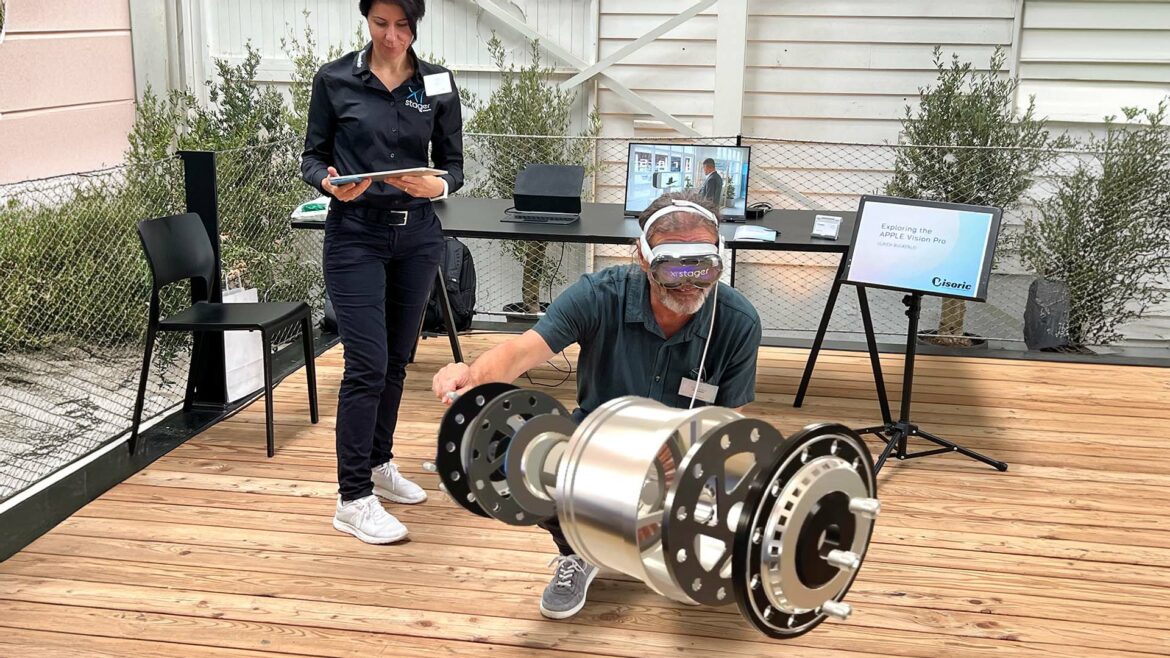Nataliya Daniltseva from the Visoric Spatial Computing Expert Team demonstrates the XR Stager® technology at the Creativ Connect 3D-Design User Meeting at Lake Constance.
Photo: © Visoric GmbH / XR Stager®
Introduction
The Creativ Connect 3D-Design User Meeting at Lake Constance was a unique event that redefined the boundaries of digital transformation. It was a great honor for the Visoric GmbH’s Spatial Computing Expert Team to introduce over 100 design experts from various industries, with strong representation from the automotive sector, to the exciting field of Spatial Computing with the Apple Vision Pro. The Visoric GmbH presented their Spatial Computing and Industrial Metaverse platform, XR Stager®.
The XR Stager® makes it easy to transform CAD data into photorealistic, fully animated digital product twins and present them on a variety of headset devices such as the Apple Vision Pro, the Magic Leap 2, the Meta Quest 3, or the Vive, as well as on holographic displays, powerwalls, or through the intranet browser.
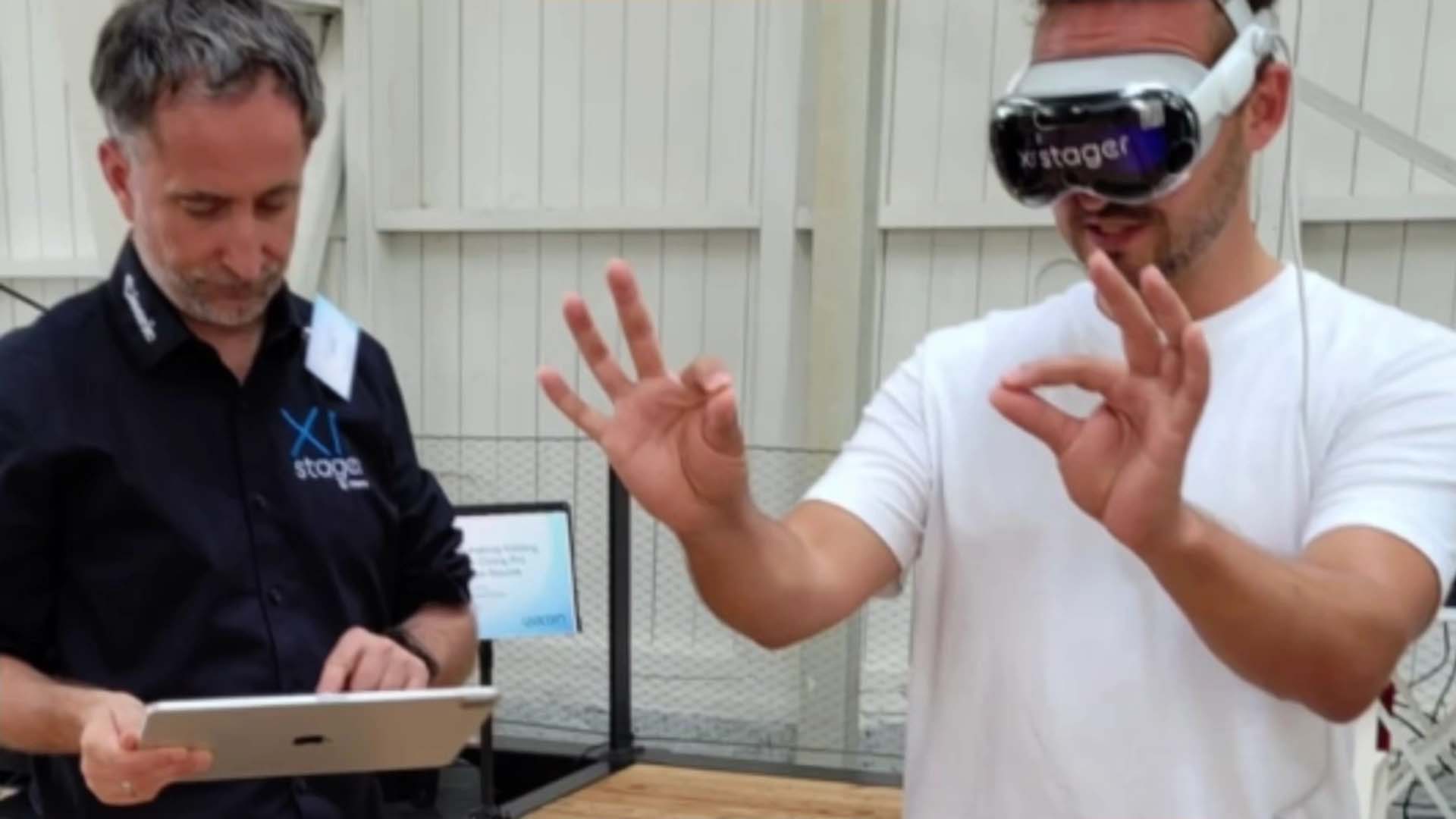
Ulrich Buckenlei, Digital Transformation Expert from the Visoric Spatial Computing Expert Team, demonstrates the XR Stager® technology at the Creativ Connect 3D-Design User Meeting.
Photo: © Visoric GmbH / XR Stager®
Action Recommendations for Spatial Computing for Designers in the Industrial Sector
To benefit from Spatial Computing, companies should develop a clear strategy and take the right steps.
Implementation and Strategy:
- Needs Analysis: Identify the areas where Spatial Computing can add value.
- Technology Selection: Choose the appropriate hardware and software for specific requirements.
- Pilot Projects: Conduct test projects to gain experience and evaluate technologies.
- Training: Train employees in handling the new technologies.
- Evaluation: Regularly review and adjust strategies and projects.
Key Functions:
- 3D Geospatial Mapping: Converts real-time industrial data into interactive 3D models.
- Real-time Navigation: Overlays production processes and operational data directly onto the real world.
- Virtual Simulations: Allows designers and engineers to test products and processes in a simulated environment.
- AI Integration: Analyzes and interprets industrial data for better results and optimized processes.
Benefits of Spatial Computing:
- Increased Efficiency: Processes can be designed faster and more accurately using 3D visualizations and real-time data.
- Cost Reduction: Virtual simulations and prototypes help save costs for physical models and test runs.
- Improved Collaboration: Interactive 3D models and real-time navigation promote collaboration between different departments and locations.
- Innovation Promotion: AI-driven analyses provide new insights and opportunities for product development and process optimization.

Nataliya Daniltseva from the Visoric Spatial Computing Expert Team demonstrates the XR Stager® technology at the Creativ Connect 3D-Design User Meeting.
Photo: © Visoric GmbH / XR Stager®
Practical Application Examples
Spatial Computing offers a variety of practical applications for designers and engineers in the industrial sector. These innovative technologies enable the optimization of complex processes, increase efficiency, and open up new possibilities for product development and optimization. By using 3D geospatial mapping, virtual simulations, and real-time navigation, companies can significantly improve their design and manufacturing processes while promoting collaboration and learning within the organization. Here are some concrete application examples that illustrate the diverse uses of Spatial Computing:
- Product Design: Designers can visualize complex products using 3D geospatial mapping and virtual simulations and adjust their designs in real-time.
- Manufacturing Optimization: Engineers can analyze and optimize production processes with real-time navigation and AI integration to improve efficiency and quality.
- Training and Education: Employees can be trained in a practical way through virtual simulations and immersive training environments, leading to faster and more effective onboarding.
- Maintenance and Repair: Technicians can carry out maintenance and repair work more efficiently using AR applications and 3D models by receiving precise instructions and visualizations.
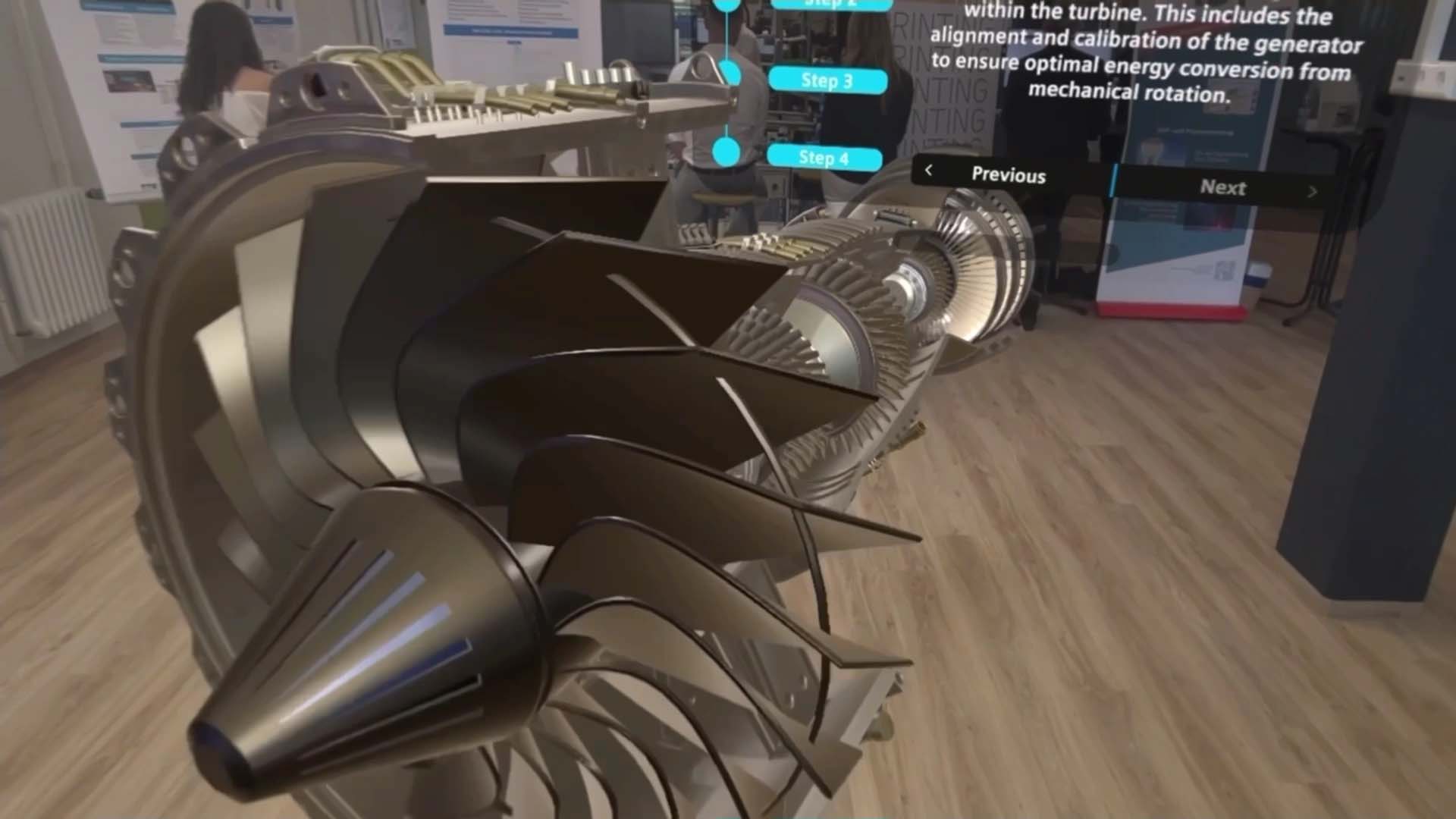
The assembly instructions for a turbine are just one example of how the XR Stager Spatial Computing platform is used in companies.
Photo: © Visoric GmbH / XR Stager®
Case Studies
The application of Spatial Computing technologies in various industries impressively demonstrates how these innovative solutions can increase efficiency and productivity. By using 3D geospatial mapping, virtual simulations, and real-time navigation, companies can optimize not only their design and manufacturing processes but also improve collaboration and training for their employees. Here are some case studies that illustrate the successful implementations of Spatial Computing in practice and show the significant benefits of these technologies.
- Automotive Industry: A leading automotive manufacturer uses XR Stager® to develop design prototypes faster and make production processes more efficient. Virtual simulations have reduced development time by 30% and significantly lowered production costs.
- Aerospace: An aerospace company implemented Spatial Computing to improve the maintenance processes of its aircraft. Technicians received precise instructions via AR headsets, reducing repair times by 40%.
- Construction Industry: A construction company used 3D geospatial mapping to better plan and implement complex construction projects. This led to improved collaboration and a 20% reduction in construction costs.
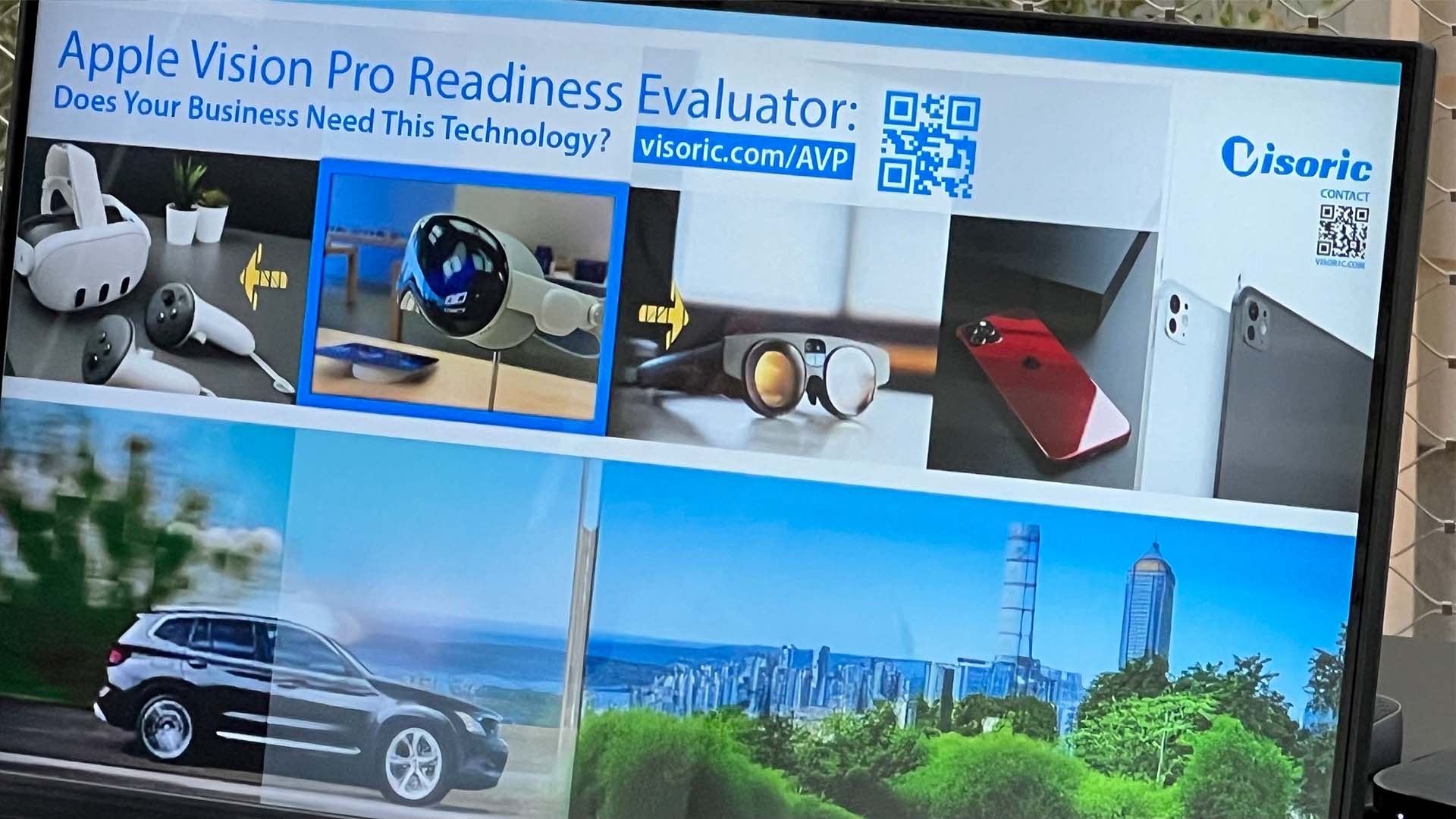
With the Apple Vision Pro Readiness Evaluator, the Visoric Spatial Computing Team has developed an online test where companies can find out for free if the Apple Spatial Computing Headset fits their company and how likely it is to generate added value.
Photo: © Visoric GmbH / XR Stager®
Future Prospects
Spatial Computing will continue to play a transformative role in the industry in the coming years. Through continuous innovations and developments, new application fields will be opened up and existing processes further optimized. Companies that adopt these technologies early on will enjoy long-term competitive advantages and strengthen their market position.
- Expansion of Application Fields: New developments in Spatial Computing will open up further industrial sectors and optimize their processes.
- Improved Technology Integration: Advances in hardware and software will facilitate the seamless integration of Spatial Computing into existing systems.
- Increased User-Friendliness: More intuitive user interfaces and easier operation will increase the acceptance and use of Spatial Computing technologies.
- Enhanced Reality Experiences: Advances in Augmented Reality (AR) and Virtual Reality (VR) will enable more immersive and realistic user experiences.
- Increased Competitiveness: Companies that adopt Spatial Computing early on will strengthen their market position and secure long-term competitive advantages.
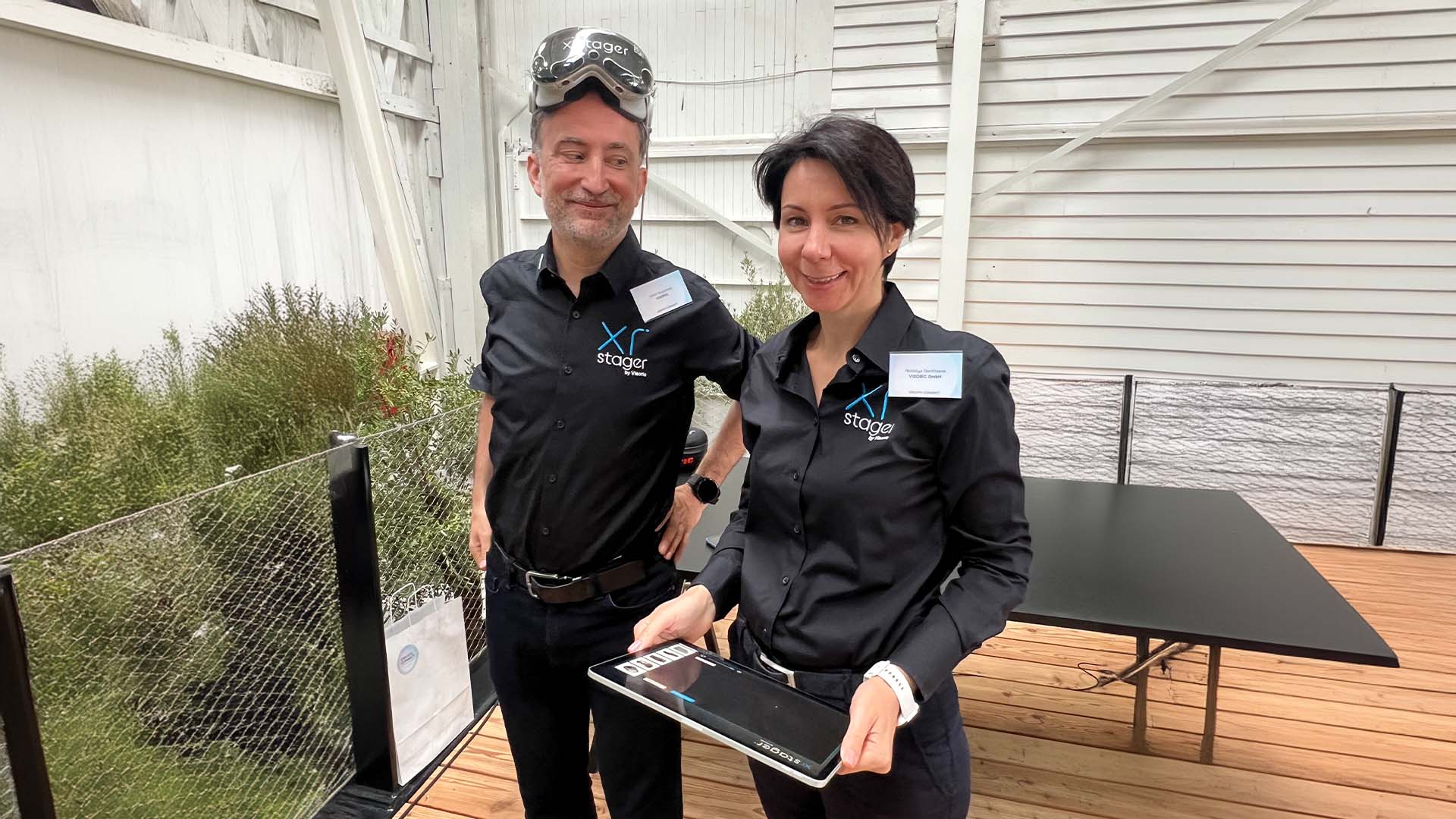
Nataliya Daniltseva (1st from right) and Ulrich Buckenlei (1st from left) from the Visoric Spatial Computing Expert Team are happy to provide individual consultations and show you how your company can benefit from modern 3D technology. Visoric is ready to accompany your company into the digital future.
Photo: © Visoric GmbH / XR Stager®
Conclusion
Spatial Computing offers designers and engineers in the industrial sector numerous opportunities to revolutionize and make their work more efficient. By implementing these technologies, companies can not only reduce costs and increase productivity but also foster their employees’ innovative capabilities. Visoric GmbH stands ready as a competent partner to accompany companies on this path and provide customized solutions.
- Efficiency Increase: Spatial Computing enables faster and more precise design and manufacturing processes.
- Cost Reduction: Virtual simulations and digital twins help save costs for physical models and test runs.
- Improved Collaboration: Interactive 3D models promote collaboration and communication between different departments and locations.
- Innovation Promotion: AI-driven analyses and immersive technologies offer new insights and foster employees’ innovative capabilities.
- Competitive Advantage: Companies that adopt Spatial Computing early on secure long-term competitive advantages and strengthen their market position.
Video: Consultation and Presentation by Visoric at Creative Connect 2024
This video shows the consultation and presentation by the Visoric Spatial Computing Expert Team at Creative Connect 2024. Nataliya Daniltseva and Ulrich Buckenlei demonstrate how modern 3D technologies can lead companies into the digital future.
Video © Visoric GmbH | Consultation and presentation by the Visoric Spatial Computing Expert Team at Creative Connect 2024
Contacting the Visoric Expert Team
Explore the multifaceted application possibilities of the XR Stager Digital Twin iPad Control and take a key role in the evolution of your industry. With support from Visoric and the XR Stager Industrial Metaverse & Spatial Computing Platform, you can easily and securely take the next step into the digital future. Let us show you how XR Stager solutions can advance your digital initiatives. Contact us now for a customized consulting!
Contact Us:
Email: info@xrstager.com
Phone: +49 89 21552678
Ansprechpartner:
Ulrich Buckenlei (Creative Director)
Mobil +49 152 53532871
Mail: ulrich.buckenlei@xrstager.com
Nataliya Daniltseva (Projekt Manager)
Mobil + 49 176 72805705
Mail: nataliya.daniltseva@xrstager.com
Address:
VISORIC GmbH
Bayerstraße 13
D-80335 Munich


